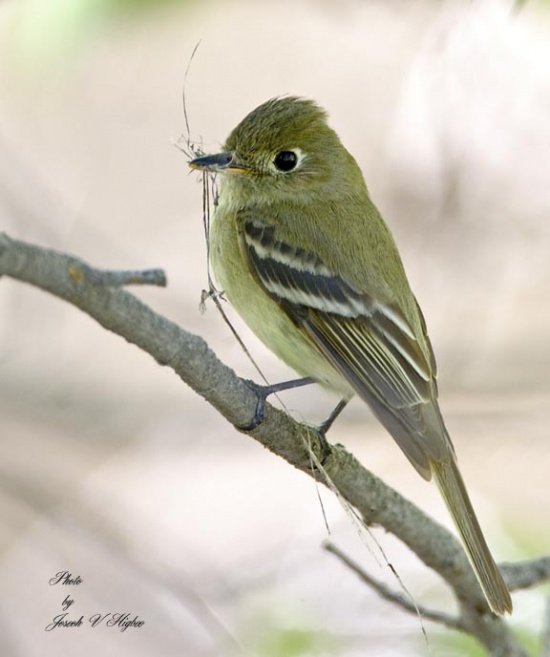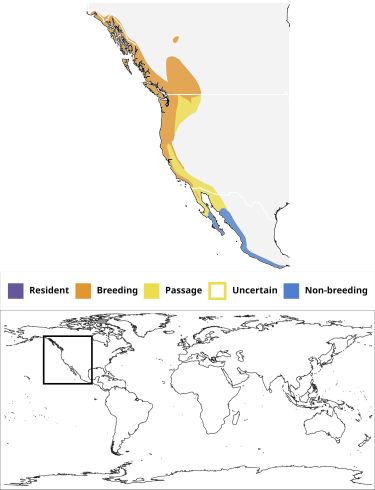(change of photo) |
m |
||
| (22 intermediate revisions by 8 users not shown) | |||
| Line 1: | Line 1: | ||
| − | + | [[Image:Pacific-slope_Flycatcher.jpg|thumb|550px|right|Photo © by {{user|jvhigbee|Joseph V. Higbee}}.<br/>Yakima County, [[Washington]], [[USA]], 25 May 2005.]] | |
| − | [[Image:Pacific-slope_Flycatcher.jpg|thumb|550px|right|Photo by jvhigbee<br /> | + | ;[[:Category:Empidonax|Empidonax]] difficilis |
| + | ==Identification== | ||
| + | Length: 12.75cm (5in). Head is triangular in shape with a white eye ring, lower mandible is orange, upperparts are brown-olive, olive breast, yellow throat, belly and undertail coverts, 2 white-yellow wing bars. | ||
| + | It is very difficult to distinguish from the [[Cordilleran Flycatcher]] (''Empidonax occidentalis'') in the field, except by the call of the male. In winter, both species migrate south to [[Mexico]], where they are virtually indistinguishable from one another. | ||
| + | ===Similar Species=== | ||
| + | * [[Cordilleran Flycatcher]]: physically indistinguishable except by voice in the males. Location is the best determinate.<br> | ||
| + | * [[Yellow-bellied Flycatcher]]: has shorter tail than ''E. difficilis'', and brighter, more yellow wing bars. It also lacks the partial crest and has a more round (less almond-shaped) eyering. | ||
| − | + | Likely to overlap with [[Alder Flycatcher]], [[Buff-breasted Flycatcher]], [[Cordilleran Flycatcher]], [[Dusky Flycatcher]], [[Gray Flycatcher]], [[Hammond's Flycatcher]], [[Least Flycatcher]], [[Pine Flycatcher]], [[White-throated Flycatcher]], [[Willow Flycatcher]], [[Yellow-bellied Flycatcher]]. | |
| − | |||
| − | + | See also [[Empidonax|<i>Empidonax</i>]]. | |
==Distribution== | ==Distribution== | ||
| − | + | Western [[North America]]. Breeds from [[Alaska]] south along the coast to [[Baja California]]. Spends winters in the lowlands of western [[Mexico]]. | |
| + | [[File:20230517_Empidonax_difficilis.jpg|375px|thumb|right|Approximate distribution map. From Xeno canto / NatureServe data at file date (from Xeno Canto)]] | ||
==Taxonomy== | ==Taxonomy== | ||
| − | + | The Pacific-slope Flycatcher may be considered conspecific with the [[Cordilleran Flycatcher]] under the name [[Western Flycatcher]]. | |
| + | Subspecies ''insulicola'' is isolated and may deserve species status. | ||
| + | ====Subspecies==== | ||
| + | Clements recognises the following subspecies [[#References|[1]]]: | ||
| + | *''E. d. difficilis'': Western [[North America]] (southeast [[Alaska]] to northern [[Baja California]]); winters to southern [[Mexico]] | ||
| + | *''E. d. insulicola'': Channel Islands off southern [[California]] | ||
| + | *''E. d. cineritius'': Cape district of [[Baja California]] | ||
==Habitat== | ==Habitat== | ||
Preferred habitats include moist, shaded coniferous or mixed forests. | Preferred habitats include moist, shaded coniferous or mixed forests. | ||
| + | ==Behaviour== | ||
| + | ====Diet==== | ||
| + | Prey is caught in the air, or from foliage. The diet is mainly flying or crawling insects. | ||
| + | ====Breeding==== | ||
| + | Nests can be made in tree stumps and upturned tree roots. The female builds the nest of moss, grass, rootlets, bark, and lichen, and lines it with hair and feathers. 3-4 eggs are laid and incubated for 14 to 15 days. Both parents feed the young, which leave the nest at about 15 days. The young stay near the nest for a few days after fledging. | ||
| + | ====Vocalisation==== | ||
| + | Song “ps-séét ptsick seet” with the ptsick section going low-high. Male position note is upslurred sinusoidal (important for distinguishing from ''E. occidentalis'') which has this note two-parted. Female position note a brief “tsip” or “tsit”, similar to “seet” portion of song. <br /><br /> | ||
| − | + | {{ Audio|Pacific-slopeFlycatcher.mp3 }} | |
| − | + | [[Media:Pacific-slopeFlycatcher.mp3 |Listen to a song clip (subspecies ''E. d. difficilis'']])<br /> | |
| + | Recording © by {{user|jmorlan|Joseph Morlan}}<br /> | ||
| + | Pacifica, [[California]], 03 April 2020 | ||
| − | + | ====Movements==== | |
| + | Medium-distance migrant, wintering in Mexico; breeding birds in Southern Baja California (race ''cineritius'') resident. | ||
| − | Pacific-slope | + | ==References== |
| + | #{{Ref-Clements6thAug19}}#Lowther, P. E., P. Pyle, and M. A. Patten (2020). Pacific-slope Flycatcher (''Empidonax difficilis''), version 1.0. In Birds of the World (P. G. Rodewald, Editor). Cornell Lab of Ornithology, Ithaca, NY, USA. https://doi.org/10.2173/bow.pasfly.01 | ||
| + | #Farnsworth, A. & Lebbin, D. (2020). Pacific-slope Flycatcher (''Empidonax difficilis''). In: del Hoyo, J., Elliott, A., Sargatal, J., Christie, D.A. & de Juana, E. (eds.). Handbook of the Birds of the World Alive. Lynx Edicions, Barcelona. (retrieved from https://www.hbw.com/node/57359 on 14 April 2020). | ||
==External Links== | ==External Links== | ||
| + | Search the Gallery using the scientific name: | ||
{{GSearch|Empidonax+difficilis}} | {{GSearch|Empidonax+difficilis}} | ||
| − | [[Category:Birds]] | + | Search the Gallery using the common name: |
| + | {{GSearch|"Pacific-slope Flycatcher"}} | ||
| + | {{GS-checked}} | ||
| + | <br /> | ||
| + | <br /> | ||
| + | |||
| + | [[Category:Birds]] [[Category:Empidonax]] | ||
Latest revision as of 12:55, 12 October 2023
- Empidonax difficilis
Identification
Length: 12.75cm (5in). Head is triangular in shape with a white eye ring, lower mandible is orange, upperparts are brown-olive, olive breast, yellow throat, belly and undertail coverts, 2 white-yellow wing bars. It is very difficult to distinguish from the Cordilleran Flycatcher (Empidonax occidentalis) in the field, except by the call of the male. In winter, both species migrate south to Mexico, where they are virtually indistinguishable from one another.
Similar Species
- Cordilleran Flycatcher: physically indistinguishable except by voice in the males. Location is the best determinate.
- Yellow-bellied Flycatcher: has shorter tail than E. difficilis, and brighter, more yellow wing bars. It also lacks the partial crest and has a more round (less almond-shaped) eyering.
Likely to overlap with Alder Flycatcher, Buff-breasted Flycatcher, Cordilleran Flycatcher, Dusky Flycatcher, Gray Flycatcher, Hammond's Flycatcher, Least Flycatcher, Pine Flycatcher, White-throated Flycatcher, Willow Flycatcher, Yellow-bellied Flycatcher.
See also Empidonax.
Distribution
Western North America. Breeds from Alaska south along the coast to Baja California. Spends winters in the lowlands of western Mexico.
Taxonomy
The Pacific-slope Flycatcher may be considered conspecific with the Cordilleran Flycatcher under the name Western Flycatcher.
Subspecies insulicola is isolated and may deserve species status.
Subspecies
Clements recognises the following subspecies [1]:
- E. d. difficilis: Western North America (southeast Alaska to northern Baja California); winters to southern Mexico
- E. d. insulicola: Channel Islands off southern California
- E. d. cineritius: Cape district of Baja California
Habitat
Preferred habitats include moist, shaded coniferous or mixed forests.
Behaviour
Diet
Prey is caught in the air, or from foliage. The diet is mainly flying or crawling insects.
Breeding
Nests can be made in tree stumps and upturned tree roots. The female builds the nest of moss, grass, rootlets, bark, and lichen, and lines it with hair and feathers. 3-4 eggs are laid and incubated for 14 to 15 days. Both parents feed the young, which leave the nest at about 15 days. The young stay near the nest for a few days after fledging.
Vocalisation
Song “ps-séét ptsick seet” with the ptsick section going low-high. Male position note is upslurred sinusoidal (important for distinguishing from E. occidentalis) which has this note two-parted. Female position note a brief “tsip” or “tsit”, similar to “seet” portion of song.
Listen to a song clip (subspecies E. d. difficilis)
Recording © by Joseph Morlan
Pacifica, California, 03 April 2020
Movements
Medium-distance migrant, wintering in Mexico; breeding birds in Southern Baja California (race cineritius) resident.
References
- Clements, J. F., T. S. Schulenberg, M. J. Iliff, S. M. Billerman, T. A. Fredericks, B. L. Sullivan, and C. L. Wood. 2019. The eBird/Clements Checklist of Birds of the World: v2019. Downloaded from http://www.birds.cornell.edu/clementschecklist/download/
- Lowther, P. E., P. Pyle, and M. A. Patten (2020). Pacific-slope Flycatcher (Empidonax difficilis), version 1.0. In Birds of the World (P. G. Rodewald, Editor). Cornell Lab of Ornithology, Ithaca, NY, USA. https://doi.org/10.2173/bow.pasfly.01
- Farnsworth, A. & Lebbin, D. (2020). Pacific-slope Flycatcher (Empidonax difficilis). In: del Hoyo, J., Elliott, A., Sargatal, J., Christie, D.A. & de Juana, E. (eds.). Handbook of the Birds of the World Alive. Lynx Edicions, Barcelona. (retrieved from https://www.hbw.com/node/57359 on 14 April 2020).
External Links
Search the Gallery using the scientific name:
Search the Gallery using the common name:
GSearch checked for 2020 platform.





